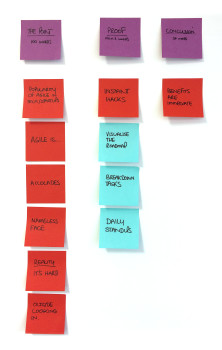In this guest post, Darren Segal of Hardhat Digital explains how a focus on “granular thinking” and “agility” can change your business in an afternoon.

With the success of businesses like Atlassian and Campaign Monitor, it’s no surprise that more enterprise companies are thinking and behaving like the hottest, billion-dollar ‘unicorn’ start-ups. The ostensible secret sauce is ‘agile’.
So what is agile? Simply put, it’s a method that is transforming the way companies deliver work to get products to market in a quick and iterative way.
Adopting agile practices in your agency makes life easier. Reduced overheads, minimal documentation, no useless meetings and clear communication with all stakeholders. It creates a collaborative, transparent and focused environment that allows for change, rapid delivery of work and a clear direction to the end goal.
ADVERTISEMENT
Best of all, people spend less time in meetings and more time getting things done.
Sounds pretty good, right? No wonder everyone’s drinking the agile Kool-Aid, compelling traditional businesses to ‘get on board’!
Some might say that being agile is a key to success for many tech start-ups and traditional business should replicate their methods. While this idea makes for a good keynote presentation, it misses the mark in reality. Like any major organisational change, ‘going agile’ can be a difficult, stressful and an expensive process – but it doesn’t have to be all-or-nothing. You can start small and still get some big benefits.
Here are three killer points you can put in place this afternoon that will make an immediate impact.
1. Visualise the Roadmap
- A hallmark of any agile environment is lots of Post-it notes or cards stuck up on the wall around the office.
- Visualising requirements provides a clear and transparent hierarchical communication tool for any project.
- Write the important stuff down and stick it on a wall for everyone to see.
- The process of doing this needs to be visible. This ensures the team discusses every task and everyone has the same understanding.
- Post-it notes are typically a grouping of tasks required to consider a project complete.
2. Break down Tasks
- People are often bad at estimating big things but good at estimating small things.
- Regardless of the project you are trying to complete, always break down Tasks.
- Tasks are as applicable as setting goals. They need to be broken down into achievable and understandable blocks. As the saying goes: Failing to plan is planning to fail.
- The rule of thumb is that any task that takes more than four hours to accomplish should be broken down further. For instance, if one tasks takes 12 hours, it should be broken into three smaller tasks of four hours each.
- Getting granular can completely shift the way you communicate internally and externally. The team will be able to answer questions about each task and the see how all the tasks connect to the bigger picture.
3. Daily Stand-ups
- Be a winning team and start every day with a stand-up to get the team on the same page.
- Start small and focus on outcomes – even if it’s just you and your direct report to start with. With practice it should be 30sec per person. To start with, it might take a minute per person, but in time, you’ll have it down to 20-30 seconds.
- Use these three questions to run the stand up:
- What did you accomplish yesterday (outcomes)
- What do you intend to accomplish today (priorities)
- Any roadblocks (dependencies)
- One huge benefit of daily stand-ups are that it forces individuals to confront ambiguity daily. It helps identify and discuss red-flags or roadblocks which stops people from putting things off.
- It also gives the team the ability to divide and conquer and estimate how long things will take you.
If all you do is start with these three tips, you’ll have a bag of tricks to:
- Clarify concepts
- Reinforce team understanding
- Ease the assimilation of knowledge
- Identify roadblocks early on
Becoming agile might be difficult at first and it won’t turn your taxi company into the next Uber overnight, but you’ll realise the benefits almost immediately.
The best part, is that you can start small. I even used these points to structure this article and break down the content areas.

The agility road map
Darren Segal is director of Sydney at Hardhat Digital – www.hhd.com.au